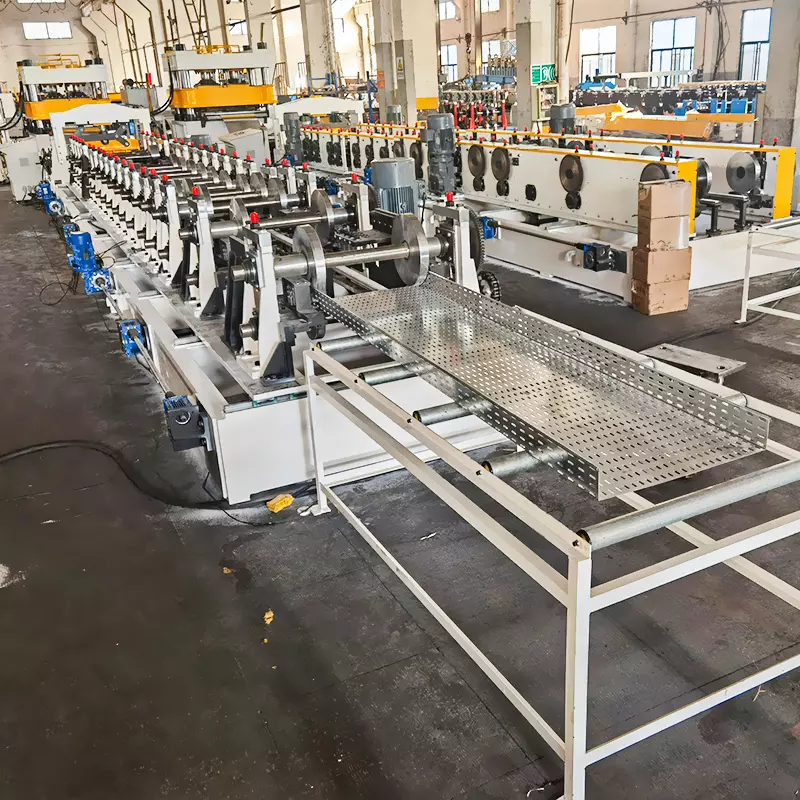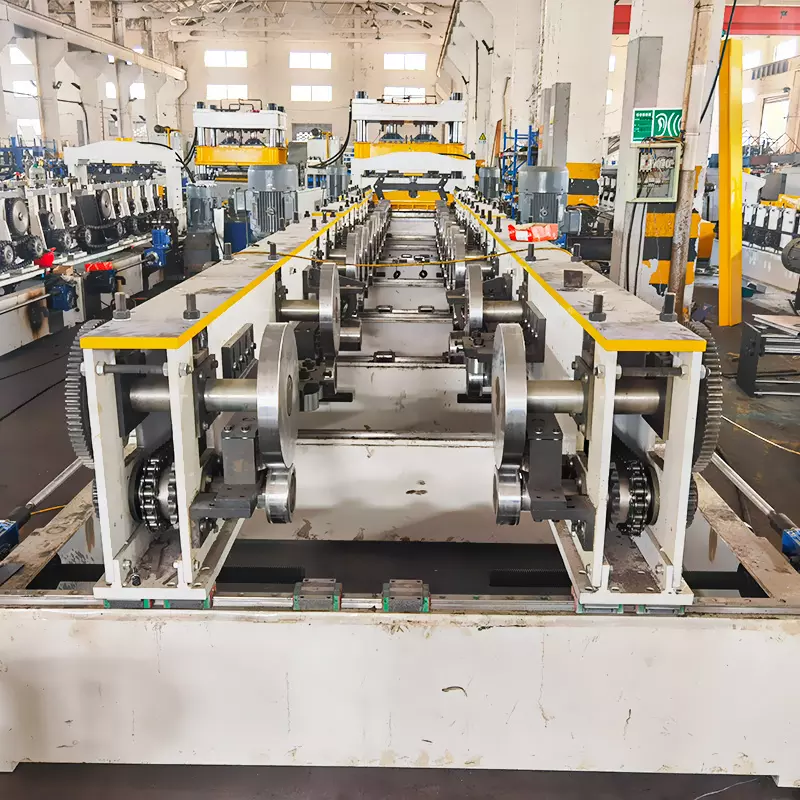Введение
Когда дело доходит до metal forming, two of the most commonly used techniques are валковая формовка и прессовое торможение. Both processes shape metal sheets into precise profiles, but they differ in speed, efficiency, cost, and suitability for different applications.
So, which one should you choose?
In this guide, we’ll compare roll forming vs. press braking в 2025, covering:
✅ How each process works
✅ Key differences in speed, cost, precision, and efficiency
✅ Best applications for each method
✅ Which industries rely on roll forming vs. press braking?
✅ Why roll forming is the preferred choice for high-volume production
Давайте погрузимся!
Понятие о валковой формовке
Что такое профилирование?
Roll forming is a continuous metal forming process that shapes sheet metal into long, uniform profiles используя a series of roller stations. The material passes through multiple rollers that gradually shape it into the desired cross-section.
Как работает роликовая формовка
| Шаг | Process Description |
|---|---|
| 1. Загрузка катушки | A metal coil is fed into the roll forming machine. |
| 2. Progressive Forming | The sheet passes through a series of rollers that gradually bend the metal into shape. |
| 3. Inline Cutting & Punching | The profile is cut to length и punched if necessary. |
| 4. Final Inspection & Packaging | Готовые профили quality-checked and prepared for shipment. |
Совет профессионала: Roll forming is best for high-volume, continuous production из uniform metal profiles.
Understanding Press Braking
What is Press Braking?
Press braking is a metal bending process that uses a гидравлический or mechanical press brake to bend metal sheets into specific angles. The metal is placed between a punch and die, which exert force to form the sheet into the desired shape.
How Press Braking Works
| Шаг | Process Description |
|---|---|
| 1. Sheet Placement | A flat metal sheet is positioned on the press brake. |
| 2. Die & Punch Selection | The appropriate die and punch combination is chosen for the required bend. |
| 3. Bending Process | The press brake applies force, bending the sheet into the desired angle. |
| 4. Inspection & Adjustment | The formed part is checked for accuracy and adjusted if necessary. |
Совет профессионала: Press braking is best for low-volume production и custom one-off bends.

Roll Forming vs. Press Braking: Key Differences
| Характеристика | Профилирование | Торможение нажатием |
|---|---|---|
| Скорость производства | Continuous, high-speed production (up to 50m/min) | Slower, batch-based production |
| Лучшее для | Крупносерийное производство из uniform profiles | Low-volume, custom bends |
| Стоимость оснастки | Higher initial tooling cost but lower per-unit cost | Lower tooling cost but higher per-unit cost |
| Гибкость | Limited to pre-designed profiles | Highly flexible for custom bends |
| Precision & Tolerance | Highly precise, minimal distortion in long profiles | Good for shorter sections, but less accurate for long profiles |
| Материальные отходы | Minimal waste due to continuous process | More waste due to trial-and-error adjustments |
| Автоматизация | Fully automated with inline cutting, punching, and welding | Требуется ручные настройки |
| Labor Intensity | Low labor requirement | High labor requirement |
Вердикт:
- Roll forming is better for large-scale industrial production где speed, consistency, and cost-efficiency matter.
- Press braking is better for custom, small-batch, or prototype production где flexibility is required.
When to Use Roll Forming vs. Press Braking
Roll Forming is Best For:
✅ Крупносерийное производство (e.g., automotive, construction, solar industries)
✅ Long, uniform profiles (e.g., C & Z purlins, metal roofing, highway guardrails)
✅ Reducing material waste and labor costs
✅ Achieving high precision with minimal distortion
Press Braking is Best For:
✅ Low-volume, custom jobs (e.g., small fabrication shops, prototyping)
✅ Short-length metal components that require angular bends
✅ Quick setup with minimal tooling costs
If you need high-speed, cost-efficient production, go with roll forming. If you need flexibility for low-volume jobs, press braking is the better choice.
Industries That Use Roll Forming vs. Press Braking
| Промышленность | Профилирование | Торможение нажатием |
|---|---|---|
| Автомобильная промышленность | Structural components, crash-resistant beams | Custom brackets, low-volume parts |
| Строительство | Metal roofing, wall panels, purlins | Custom trim, window frames |
| Стеллажи и полки | Warehouse storage racks, uprights, beams | Custom shelf brackets |
| Солнечная энергия | PV mounting structures, solar panel frames | Small mounting brackets |
| Аэрокосмическая промышленность | High-strength structural components | Custom one-off parts |
Совет профессионала: Roll forming is widely used in industries requiring mass production, while press braking serves more niche, low-volume applications.
Why Roll Forming is the Future of Metal Forming
As industries move towards automation, efficiency, and cost reduction, roll forming is becoming the preferred choice for large-scale manufacturers.
Advantages of Roll Forming Over Press Braking
✅ 50% faster production speeds
✅ 70% lower labor costs due to automation
✅ Минимальные отходы материалов
✅ Inline processing reduces post-production work
✅ Perfect for industries with high-volume needs
Looking for a high-speed, precision roll forming machine? Sunway Machine предлагает Самые современные решения в области валковой формовки для global manufacturers.
Common Problems & Solutions in Roll Forming vs. Press Braking
Даже с advanced roll forming and press braking technologies, manufacturers may encounter challenges such as material deformation, misalignment, and production inefficiencies. Решение этих вопросов рано обеспечивает consistent quality, reduced downtime, and improved efficiency.
Troubleshooting Guide for Roll Forming vs. Press Braking
| Выпуск | Roll Forming Cause & Solution | Press Braking Cause & Solution |
|---|---|---|
| Искажение профиля | Misaligned rollers, incorrect pressure settings → Recalibrate rollers and adjust forming pressure | Incorrect punch and die selection → Use properly matched punch and die |
| Material Wrinkling | Uneven material feeding → Ensure uniform material tension and adjust guide rolls | Over-bending of the sheet → Reduce bending force or adjust die clearance |
| Несогласованные размеры | Roller wear or incorrect CNC settings → Inspect rollers and recalibrate CNC programs | Manual setup errors → Use automated press brakes for higher accuracy |
| Царапины на поверхности | Dirty rollers or improper lubrication → Clean rollers and apply anti-scratch coatings | Poor-quality punch/die or excessive force → Use high-precision tools and adjust force settings |
| Slow Production Speed | Overloaded machine or incorrect material thickness → Optimize material input and machine settings | Manual bending sequence errors → Use CNC-controlled press brakes |
Совет профессионала: Обычный machine calibration and preventive maintenance можно reduce errors by up to 60% и increase production efficiency significantly.
Future Trends in Roll Forming & Press Braking (2025 & Beyond)
The metal forming industry is evolving rapidly, with automation, AI, and sustainability формируя будущее roll forming and press braking technologies.
Key Innovations for 2025
1. AI-Powered Quality Monitoring
- Управляемые искусственным интеллектом real-time defect detection improves quality control.
- Reduces material waste and ensures consistent accuracy.
2. Умные фабрики с поддержкой IoT
- Machines are now integrated with облачный мониторинг, позволяя дистанционная диагностика и предиктивное обслуживание.
- Улучшает отслеживание производства и повышение эффективности работы.
3. Servo-Driven Press Brakes & Roll Forming Machines
- Улучшает контроль скорости, точность и энергоэффективность.
- Уменьшает износ механических компонентовЭто увеличивает срок службы машины.
4. Полностью автоматизированная настройка профиля
- Устраняет ручные настройки при переключении между различными профилями.
- С ЧПУ automatic profile changeovers сократить время простоя и повысить эффективность.
Upgrading to AI-powered roll forming and press braking technologies can increase production efficiency by up to 50%!

Automation in Roll Forming vs. Press Braking
Автоматизация - это революция roll forming and press braking, making them Умнее, быстрее и экономичнее.
Comparison of Automation Features in Roll Forming & Press Braking
| Automation Feature | Профилирование | Торможение нажатием |
|---|---|---|
| CNC & PLC Control | Ensures precise profile formation with minimal waste | Fully automated bending sequences for accuracy |
| Обнаружение дефектов на основе искусственного интеллекта | Identifies defects in real-time, reducing material waste | Detects bending errors and corrects force distribution |
| IoT и удаленный мониторинг | Allows manufacturers to track machine performance remotely | Enables predictive maintenance and operational tracking |
| Автоматизированная смена профилей | Сокращение времени простоя при переключении между профилями | CNC-controlled punch and die selection for multi-bend jobs |
| Energy-Efficient Motors | Снижение эксплуатационных расходов и повышение устойчивости | Servo-driven systems enhance accuracy and speed |
Fully automated roll forming machines from Sunway Machine повышают эффективность производства до 40%!
Essential Maintenance Tips for Roll Forming & Press Braking Machines
Правильно обслуживание обеспечивает увеличенный срок службы оборудования и стабильное качество продукции.
Maintenance Checklist for Roll Forming & Press Braking Machines
| Задача | Частота | Назначение |
|---|---|---|
| Смазка роликов и подшипников | Еженедельник | Предотвращает износ |
| Check Roller & Die Alignment | Ежемесячно | Обеспечивает точное изготовление профилей |
| Inspect Cutting & Bending Mechanism | Ежеквартально | Prevents defective cuts, bends, and misalignment |
| Чистые компоненты машины | Ежедневно | Удаляет пыль и мусор, которые могут повлиять на производительность. |
| Обновление программного обеспечения и калибровка | Раз в полгода | Оптимизация функций автоматизации |
Совет профессионала: Плановое техническое обслуживание может увеличить срок службы машины на 50% и сократить количество отказов на 70%.
FAQ: Roll Forming vs. Press Braking
1. Which method is better for high-volume production?
- Roll forming is superior for high-volume production due to its continuous process and automation capabilities.
- Press braking is better for low-volume or custom jobs that require manual flexibility.
2. Is roll forming or press braking more cost-effective?
- Roll forming has a higher initial tooling cost but a lower per-unit cost, making it more cost-effective for large-scale production.
- Press braking has lower initial costs but higher labor expenses and slower production rates, making it less efficient for mass production.
3. Which method produces more precise parts?
- Roll forming ensures higher precision for long, uniform profiles.
- Press braking is more precise for small, angular bends but can have variations in long sections.
4. Can roll forming replace press braking entirely?
- Нет, because some industries require custom bends and low-volume production, which press braking handles better.
- However, roll forming is preferred for most industrial applications where uniformity and speed are critical.
5. What materials can be used in both methods?
- Both roll forming and press braking support steel, aluminum, stainless steel, and titanium.
- Roll forming is better for thinner materialsв то время как press braking is ideal for thicker sheets.
6. Where can I buy a high-quality roll forming machine?
Для высокоскоростные валковые формовочные машины, изготовленные по индивидуальному заказу, посетите WUXI SUNWAY MACHINERY CO., LTD..
Заключительные размышления
Both валковая формовка и прессовое торможение have their advantages, but if you’re looking for high-speed, cost-efficient, large-scale production, roll forming is the superior choice.
WUXI SUNWAY MACHINERY CO., LTD. это ведущий мировой производитель из валковые формовочные машины, изготовленные по индивидуальному заказу, предлагая Передовые технологии, экспертная поддержка и конкурентоспособные цены.
Хотите высококачественная вальцовочная машина? Свяжитесь с нами сегодня!
